Target 4
By 2031, increase the proportion of Aboriginal and Torres Strait Islander children assessed as developmentally on track in all five domains of the Australian Early Development Census (AEDC) to 55%.
Nationally in 2021, 34.3% of Aboriginal and Torres Strait Islander children commencing school were assessed as being developmentally on track in all five AEDC domains (figure CtG4.1).
This is a decrease from 35.2% in 2018 (the baseline year).
Nationally, based on progress from the baseline, the target is worsening. However, this assessment should be used with caution as it is based on a limited number of data points. Please refer to the How to interpret the data page for more information.
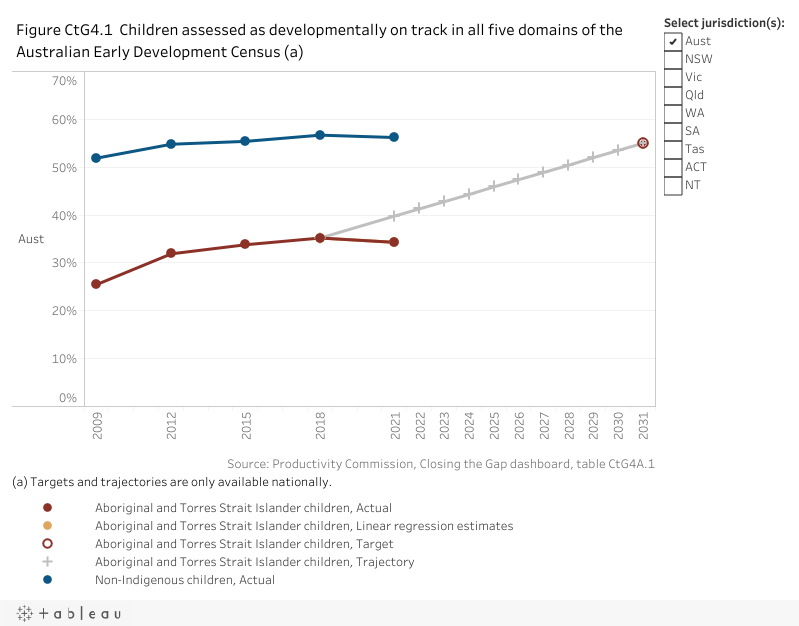
The assessment below reflects progress from the baseline (improvement, worsening or no change).
| NSW | Vic | Qld | WA | SA | Tas | ACT | NT | Aust | |
|---|---|---|---|---|---|---|---|---|---|
| Assessment of progress 2018 to 2021 |
improvement
no change
worsening not applicable as required data not available.
good improvement and target on track to be met.
improvement but target not on track to be met.
Note: These assessments of progress should be used with caution as they are based on a limited number of data points.
Disaggregations
Data tables appear under figures
By sex
Nationally in 2021, a higher proportion of Aboriginal and Torres Strait Islander girls were assessed as being developmentally on track when commencing school (41.6%) compared to boys (27.1%) (figure CtG4.2). The proportions decreased by around one percentage point for both girls and boys since the 2018 baseline year.
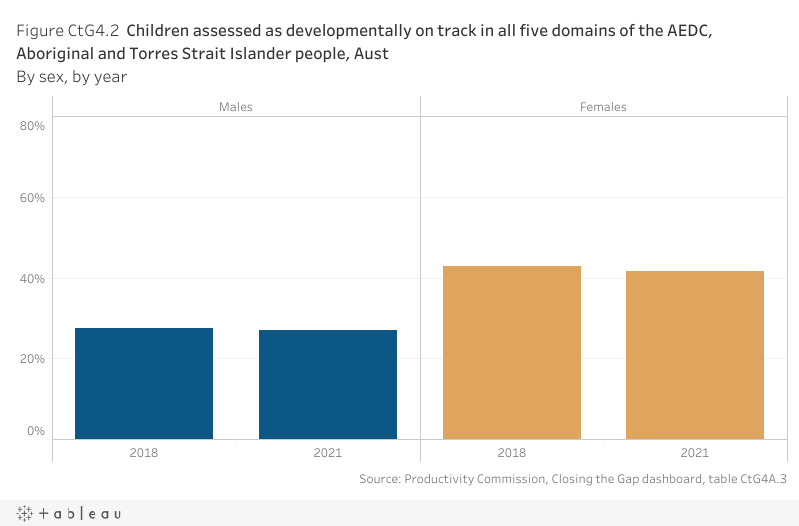
By remoteness area
Nationally in 2021, the proportion of Aboriginal and Torres Strait Islander children assessed as being developmentally on track in all five AEDC domains was highest in major cities (38.4%) (figure CtG4.3). The proportion declined with remoteness, to 16.1% in very remote areas. This is a similar pattern to the 2018 baseline year.
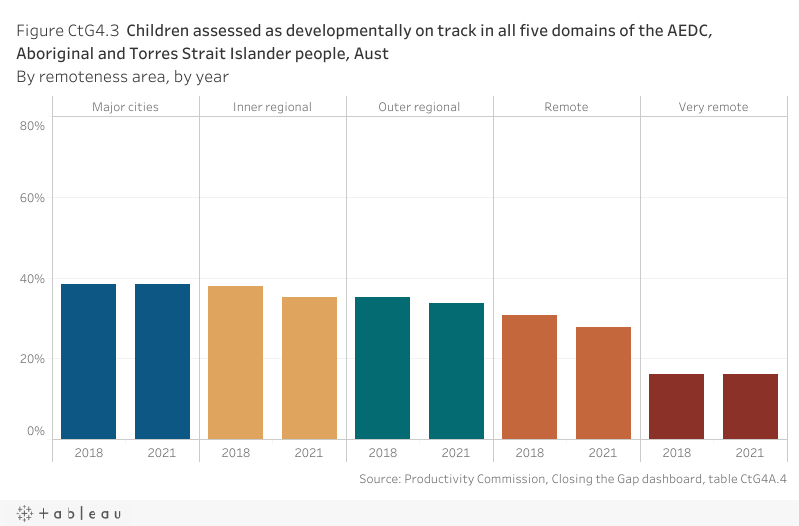
By Index of Relative Socio-economic Disadvantage (IRSD) quintile
Nationally in 2021, the proportion of Aboriginal and Torres Strait Islander children assessed as being developmentally on track in all five AEDC domains was highest in the least disadvantaged socio‑economic areas of Australia (46.9%) (figure CtG4.4). The proportion declined for children living in more disadvantaged areas, to 28.3% in the most disadvantaged socio‑economic areas of Australia. The proportions have decreased around one to two percentage points across all socio‑economic areas since the 2018 baseline year.
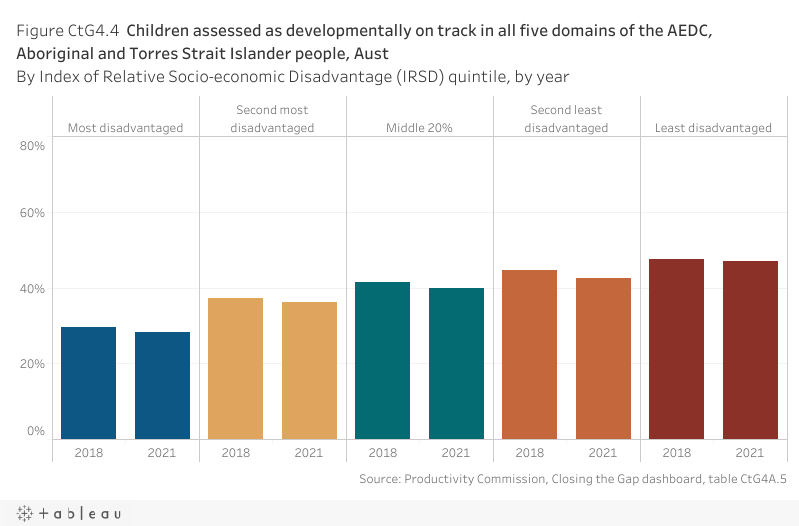
By disability status
Nationally in 2021, for Aboriginal and Torres Strait Islander children commencing school:
- 8.5% had a medically diagnosed special need, an increase from 6.4% in 2018
- 28.5% had been identified by teachers as requiring further assessment to determine if they have a developmental difficulty that affects their ability to do schoolwork in a regular classroom, an increase from 24.3% in 2018 (figure CtG4.5).
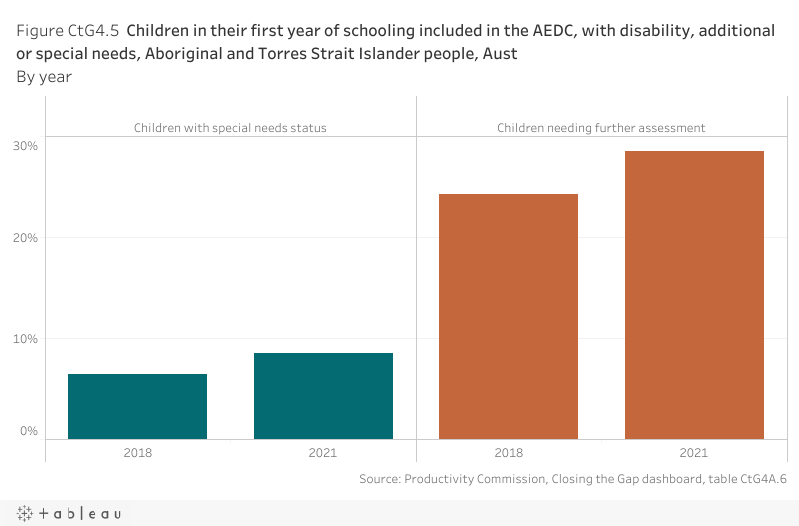
Target data specifications
Outcome: | Aboriginal and Torres Strait Islander children thrive in their early years. |
|---|---|
Target: | By 2031, increase the proportion of Aboriginal and Torres Strait Islander children assessed as developmentally on track in all five domains of the Australian Early Development Census (AEDC) to 55%. |
Indicator: | The proportion of Aboriginal and Torres Strait Islander children assessed as developmentally on track in all five domains of the AEDC. |
Measure | The measure is defined as: Numerator – number of Aboriginal and Torres Strait Islander children in the first year of full-time schooling who scored above the cut off score for developmentally on track in all five domains of the AEDC. Denominator – total number of Aboriginal and Torres Strait Islander children in the first year of full‑time schooling and is presented as a percentage. |
Target established: | National Agreement on Closing the Gap July 2020 |
Latest dashboard update: | 30 June 2022 |
Indicator type: | Target |
Interpretation of change: | A high or increasing proportion is desirable. |
Data source: | Name: AEDC microdata file. Frequency: Three‑yearly Documentation (links): https://www.aedc.gov.au |
Data provider: | Provider name: Australian Government Department of Education, Skills and Employment Provider area: Australian Early Development Census |
Baseline year: | 2018 |
Target reporting period | 2021 |
Target year: | 2031 |
Disaggregations: | State and territory and Australia, by Indigenous status. State and territory and Australia, by Indigenous status, by sex. State and territory and Australia, by Indigenous status, by remoteness area. State and territory and Australia, by Indigenous status, by Index of Relative Socio‑economic Disadvantage (IRSD) quintile. State and territory and Australia, by Indigenous status, children with disability. |
Computation: | Numerator divided by Denominator multiplied by 100. Counting rules Children who score above the 25th percentile, determined using the cut‑off points established in the first national census (2009 AEDC), are classified as ‘on track’. A set of cut‑off points define on track for each of the five domains: physical health and well-being, social competence, emotional maturity, language and cognitive skills (school‑based), and communication skills and general knowledge. Geographical variables are based on the location in which the child resides. As age is a factor contributing to children’s development, the published AEDC results control for age (excluding counts of children with disability). Includes (disability status only)
Excludes (both numerator and denominator)
Disaggregations:
|
Data quality considerations: | See http://www.aedc.gov.au for further information. The AEDC is a national population measure on how children have developed by the time they start their first year of full‑time school. Information is collected through a teacher‑completed instrument in children’s first year of full‑time schooling. For 2021, the AEDC data was collected for 305,015 children, equating to an estimated 95.5% of first year school enrolments based on ABS schools data. Of the 305,015 children with data collected for the AEDC, 20,646 children (6.8%) were Aboriginal and/or Torres Strait Islander children. Based on ABS estimates, this equates to an estimated 96.2% of first year school enrolments for Aboriginal and Torres Strait Islander children. Of the participating children, 5.7% did not have domain scores calculated or did not have sufficient information across the five domains to determine whether they are developmentally on track in all five domains (10.3% of participating Aboriginal and/or Torres Strait Islander children). Research conducted in 2007 validated the AEDC for use for Aboriginal and Torres Strait Islander children (AEDC Indigenous Adaptation Study). The target year is 2031, however the AEDC is currently only collected every three years. The closest year to the target year that the AEDC is projected to be collected is 2030. |
Supporting indicators
Driver
- Preschool attendance and enrolment
- Primary carer education level
Contextual information
- Outcomes by AEDC domains
Developmentally vulnerable, at risk, on track
- AEDC Multiple Strengths Indicator
Highly developed, well developed and emerging strengths
- Progress towards parity
Material for download
- Children thrive in their early years data tables (XLSX - 47 Kb)
- Children thrive in their early years dataset (CSV - 60 Kb)
To assist with interpretation of the data provided (Excel data tables and CSV dataset) please refer to the target data specification above.
